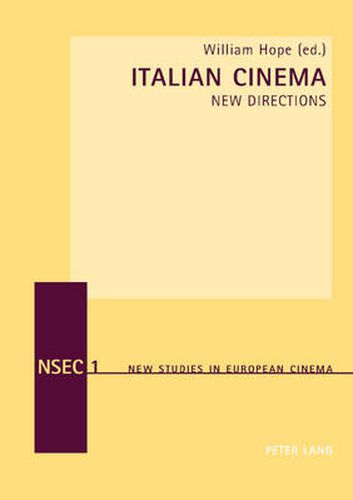Readings Newsletter
Become a Readings Member to make your shopping experience even easier.
Sign in or sign up for free!
You’re not far away from qualifying for FREE standard shipping within Australia
You’ve qualified for FREE standard shipping within Australia
The cart is loading…






This title is printed to order. This book may have been self-published. If so, we cannot guarantee the quality of the content. In the main most books will have gone through the editing process however some may not. We therefore suggest that you be aware of this before ordering this book. If in doubt check either the author or publisher’s details as we are unable to accept any returns unless they are faulty. Please contact us if you have any questions.
Italian cinema currently finds itself in a transitional phase after a highly successful period in which it was associated with the work of directors such as Rossellini, Visconti, Fellini, and Pasolini, and with innovative styles of film-making, principally neorealism. This book explores the evolution of Italian cinema over the last twenty years, with particular reference to modern masterpieces such as Tornatore’s Oscar-winning Nuovo Cinema Paradiso. The volume focuses on the work of some of the most prominent directors of recent times, combining an auteurist perspective with an incisive overview of the most important thematic and stylistic developments in modern Italian film-making.
A broad range of theoretical approaches has been selected, embracing cognitive, aesthetic, psychoanalytical, and sociological perspectives. This approach has been adopted with a view to providing the most illuminating analyses of the radically diverse work of different directors, rather than attempting to impose a single critical perspective or theme upon films that range from social realism to horror. Significantly, these different approaches are complemented by detailed discussions of the technical arrangements of given film sequences, since another of the volume’s aims is to encourage a greater familiarity with the effects of mise-en-scene, montage, sound, and camera movement.
$9.00 standard shipping within Australia
FREE standard shipping within Australia for orders over $100.00
Express & International shipping calculated at checkout
This title is printed to order. This book may have been self-published. If so, we cannot guarantee the quality of the content. In the main most books will have gone through the editing process however some may not. We therefore suggest that you be aware of this before ordering this book. If in doubt check either the author or publisher’s details as we are unable to accept any returns unless they are faulty. Please contact us if you have any questions.
Italian cinema currently finds itself in a transitional phase after a highly successful period in which it was associated with the work of directors such as Rossellini, Visconti, Fellini, and Pasolini, and with innovative styles of film-making, principally neorealism. This book explores the evolution of Italian cinema over the last twenty years, with particular reference to modern masterpieces such as Tornatore’s Oscar-winning Nuovo Cinema Paradiso. The volume focuses on the work of some of the most prominent directors of recent times, combining an auteurist perspective with an incisive overview of the most important thematic and stylistic developments in modern Italian film-making.
A broad range of theoretical approaches has been selected, embracing cognitive, aesthetic, psychoanalytical, and sociological perspectives. This approach has been adopted with a view to providing the most illuminating analyses of the radically diverse work of different directors, rather than attempting to impose a single critical perspective or theme upon films that range from social realism to horror. Significantly, these different approaches are complemented by detailed discussions of the technical arrangements of given film sequences, since another of the volume’s aims is to encourage a greater familiarity with the effects of mise-en-scene, montage, sound, and camera movement.